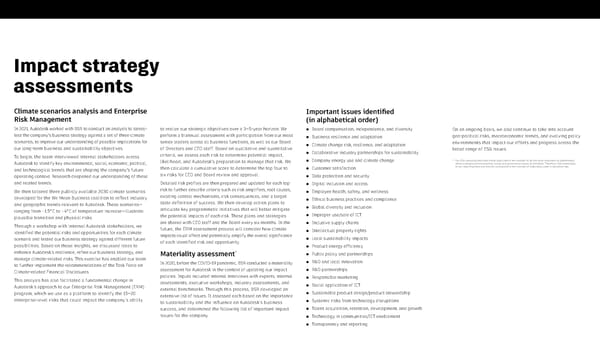Impact strategy assessments Climate scenarios analysis and Enterprise Important issues identified Risk Management (in alphabetical order) In 2021, Autodesk worked with BSR to conduct an analysis to stress- to realize our strategic objectives over a 3–5-year horizon. We ● Board compensation, independence, and diversity On an ongoing basis, we also continue to take into account test the company's business strategy against a set of three climate perform a biannual assessment with participation from our most ● Business resilience and adaptation geo-political risks, macroeconomic trends, and evolving policy scenarios, to improve our understanding of possible implications for senior leaders across all business functions, as well as our Board ● Climate change risk, resilience, and adaptation environments that impact our efforts and progress across the our long-term business and sustainability objectives. of Directors and CEO staff. Based on qualitative and quantitative ● Collaborative industry partnerships for sustainability broad range of ESG issues. To begin, the team interviewed internal stakeholders across criteria, we assess each risk to determine potential impact, likelihood, and Autodesk's preparation to manage that risk. We ● Company energy use and climate change * Our ESG reporting describes those topics which we consider to be the most important to stakeholders Autodesk to identify key environmental, social, economic, political, when evaluating environmental, social, and governance issues at Autodesk. Therefore, ESG materiality and technological trends that are shaping the company's future then calculate a cumulative score to determine the top four to ● Customer satisfaction in our reporting does not directly correspond to the concept of materiality used in securities law. operating context. Research deepened our understanding of these six risks for CEO and Board review and approval. ● Data protection and security and related trends. Detailed risk profiles are then prepared and updated for each top ● Digital inclusion and access We then tailored three publicly available 2030 climate scenarios risk to further describe criteria such as risk amplifiers, root causes, ● Employee health, safety, and wellness developed for the We Mean Business coalition to reflect industry existing control mechanisms, risk consequences, and a target ● Ethical business practices and compliance and geographic trends relevant to Autodesk. These scenarios— state definition of success. We then develop action plans to ● Global diversity and inclusion ranging from ~1.5°C to ~4°C of temperature increase—illustrate articulate key programmatic initiatives that will better mitigate plausible transition and physical risks. the potential impacts of each risk. These plans and strategies ● Improper use/sale of ICT Through a workshop with internal Autodesk stakeholders, we are shared with CEO staff and the Board every six months. In the ● Inclusive supply chains identified the potential risks and opportunities for each climate future, the ERM assessment process will consider how climate ● Intellectual property rights scenario and tested our business strategy against different future impacts could affect and potentially amplify the overall significance ● Local sustainability impacts possibilities. Based on those insights, we discussed ideas to of each identified risk and opportunity. ● Product energy efficiency enhance Autodesk’s resilience, refine our business strategy, and * ● Public policy and partnerships manage climate-related risks. This exercise has enabled our team Materiality assessment to further implement the recommendations of the Task Force on In 2020, before the COVID-19 pandemic, BSR conducted a materiality ● R&D and local innovation Climate-related Financial Disclosures. assessment for Autodesk in the context of updating our impact ● R&D partnerships This analysis has also facilitated a fundamental change in policies. Inputs included internal interviews with experts, internal ● Responsible marketing Autodesk’s approach to our Enterprise Risk Management (ERM) assessments, executive workshops, industry assessments, and ● Social application of ICT program, which we use as a platform to identify the 15–20 external benchmarks. Through this process, BSR developed an ● Sustainable product design/product stewardship enterprise-level risks that could impact the company’s ability extensive list of issues. It assessed each based on the importance to sustainability and the influence on Autodesk’s business ● Systemic risks from technology disruptions success, and determined the following list of important impact ● Talent acquisition, retention, development, and growth issues for the company. ● Technology in communities/ICT enablement ● Transparency and reporting
 Autodesk Impact Report Microsite Page 71 Page 73
Autodesk Impact Report Microsite Page 71 Page 73